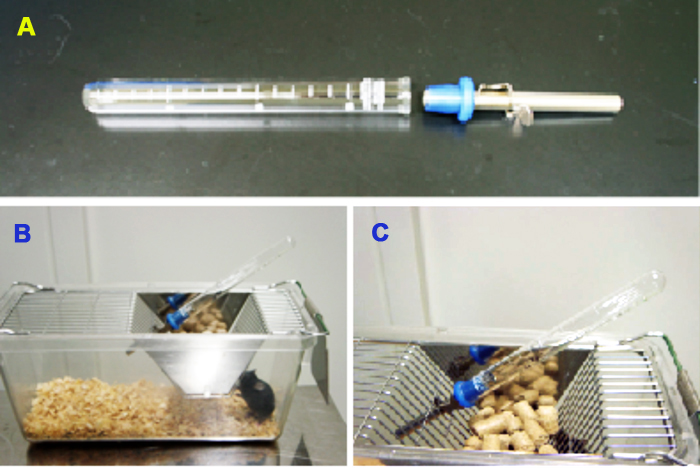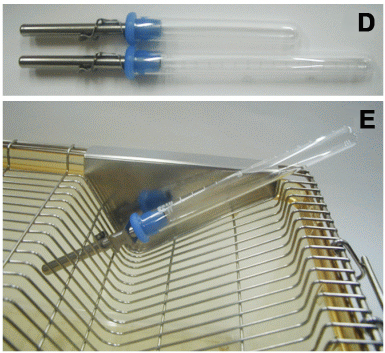Koide2 project protocol
Capsaicin intake and pain threshold in 14 inbred strains of mice, mostly wild-derived (Mishima) strains (2003)
Koide T, Furuse TProject protocol — Contents
Workflow and sampling
Equipment
Reagents, supplies, and solutions
Procedure for measuring consumption of capsaicin solution
Definitions and calculations
Data
References
Workflow
Mice are housed individually with continuous access to a water bottle (habituation period) Intake of 7 µM capsaicin solution is measured for 12 h during dark phase of one night using 1-choice bottle Intake of 10 µM capsaicin solution is measured for 12 h during dark phase of one night using 1-choice bottle Intake of 15 µM capsaicin solution is measured for 12 h during dark phase of one night using 1-choice bottle • 15 mL glass test-tubes capped with a silicon stopper with a double ball bearing nozzle (Drinko-measurer DM-G1 (Oâhara & Co. Ltd., Tokyo, Japan) (see Figure 1 below)
• Top-loading balance scale
• Ultrasonic bottle and nozzle cleaner
Figure 1. In Panels A & D, the 15 mL glass test-tubes are capped with silicon stoppers containing double ball bearing nozzles. In Panels B, C, and E, each test tube bottle is placed on the cage lid attached with a clip.Reagents, supplies, solutions Â
• Capsaicin: (8-Methyl-N-Vanillyl-6-Nonenamide, minimum 97%, Sigma Chemical Co., St Louis, MO)
1- Because capsaicin has low solubility in water, stock solution of capsaicin is prepared in ethanol (200 mmol/L).
2- The stock solution is then diluted with deionized water to 0.5, 1.0, 4.0, 7.0, 10.0, and 15.0 µM capsaicin concentration.
3- Ethanol concentration is adjusted and kept at 0.0075% in all capsaicin solutions.• Ethanol (200 mmol/L)
• Autoclaved deionized water
Procedure for measuring consumption of capsaicin solution
a. Mice are individually housed and allowed to habituate for 2 days with deionized water their water bottle.
b. Before testing for capsaicin intake, baseline water intake is measured during the entire dark phase (20:00-8:00) for 3 days and the median volume is used as (100%) water intake volume.
c. Increasing concentration of capsaicin (0.5, 1.0, 4.0, 7.0, 10.0, and 15.0 µM) solution is then offered in the same 12-h 1-bottle test manner, each time with a new set of the same type of water bottle.
d. The volume of fluid intake during the entire 12-h dark phase is measured by weighing the test bottles before and after the test period and subtracting the final weight from the initial.
e. Used bottles and nozzles are washed with an ultrasonic cleaner following each measurement.
f. Capsaicin solution intake for each mouse is calculated as percent of the median intake of each mouse during the first 3 days of baseline (water only) measurement.Submitting Investigator's Notes: "In order to examine the amount of fluid-loss during handling of bottles, we measured loss of fluid by doing the same type of handling using 50 different test bottles. Fluid-loss on average was around 0.013 mL, ranging from 0 to 0.061 mL. Because the amount of fluid-loss during handling of bottles was less than 1% of the fluid consumed by each animal in our test, we considered this source of error to be negligible."
Data collected by investigator
Fluid intake at increasing concentration of capsaicin (0.5, 1.0, 4.0, 7.0, 10.0, and 15.0 µM)
The capsaicin intake is calculated as percent of the median intake of water during baseline control period.
References
Lightfoot JT, Leamy L, Pomp D, Turner MJ, Fodor AA, Knab A, Bowen RS, Ferguson D, Moore-Harrison T, Hamilton A. Strain screen and haplotype association mapping of wheel running in inbred mouse strains. J Appl Physiol. 2010 Sep;109(3):623-34. Epub 2010 Jun 10.
PubMed 20538847 FullText

